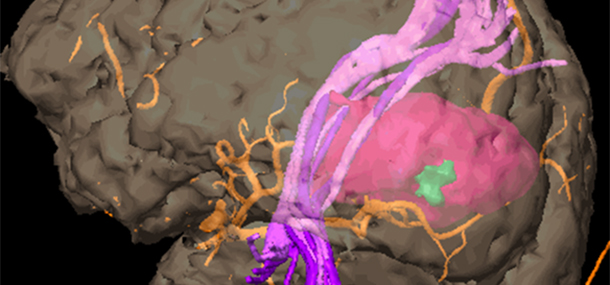
At Cincinnati Children’s, neurosurgeons and radiologists work together to give your child the best possible outcome. Imaging is routinely used in the operating room to guide surgeons to the abnormality, avoid regions of the brain that control important functions (such as speech, vision, and movement), and provide guidance during resection. Dr. James Leach recently shared our methods of intraoperative imaging with other radiologists at the American Society of Neuroradiology’s annual meeting in Chicago. Collaborating with fellow radiologist Dr. Meg Care and neurosurgeon Dr. Francesco Mangano, he demonstrated the multiple imaging techniques that can be useful in the operating room.
If your child has a brain tumor, it is likely that the doctors at Cincinnati Children’s will use advanced guidance systems, based upon MRI or CAT scan images performed on your child prior to the surgery. The tumor is outlined by the radiologist, and by using infrared cameras and markers placed on the skin, the neurosurgeon can make the smallest skull opening possible and the most direct route to get to the tumor. This is termed “neuronavigation.” By incorporating advanced techniques such as  functional MRI and tractography, regions of brain-controlling critical functions can be avoided.
functional MRI and tractography, regions of brain-controlling critical functions can be avoided.
During the procedure, the radiologists can assist the neurosurgeon by performing ultrasound to determine how much tumor is left. In many cases, we also use our state-of-the-art intraoperative MRI to get pictures during the operation to ensure the best resection possible.
Our doctors also do surgery for very bad seizures that aren’t helped by medication. Imaging is critical in these cases by helping to identify often subtle abnormalities that are the cause of seizures. By marking these regions, the radiologist helps the neurosurgeon target these areas for removal. Sometimes, no abnormality is noted on the MRI, but by using other techniques such as PET scans, MEG, and implanted electrodes, the epilepsy doctors can identify the area of brain responsible for the seizures.  By combining all of these modalities in a single operative plan, the radiologist can help coordinate removal of the region causing seizures and avoid important functional regions; once again, giving you and your child the best possible outcome.
By combining all of these modalities in a single operative plan, the radiologist can help coordinate removal of the region causing seizures and avoid important functional regions; once again, giving you and your child the best possible outcome.
 Contributed by Dr. James Leach and edited by Tony Dandino(RT-MRI).
Contributed by Dr. James Leach and edited by Tony Dandino(RT-MRI).